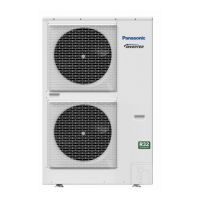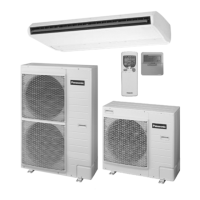vi
Precautions for Installation Using New Refrigerant
1. Care regarding tubing
(1) Process tubing
Material: Use seamless phosphorous deoxidized copper tube for refrigeration. Wall thickness shall comply with the applicable legislation. For tubes of ø22.22 or
larger, use thematerial of temper 1/2H or H (Hard copper tube). Do not bend the hard copper tube.
For the renewal tubing size, refer to the Technical Data.
Use a tube cutter when cutting the tubing, and be sure to remove any flash. This also applies to distribution joints (optional).
When bending tubing, use a bending radius that is 4 times the outer diameter of the tubing or larger.
CAUTION
Use sufficient care in handling the tubing. Seal the tubing ends with caps or tape to prevent dirt, moisture, or other foreign
substances from entering. These substances can result in system malfunction.
(2) Prevent impurities including water, dust and oxide from entering the tubing. Impurities can cause R32 refrigerant deterioration and compressor defects. Due to
the features of the refrigerant and refrigerating machine oil, the prevention of water and other impurities becomes more important than ever.
2. Be sure to recharge the refrigerant only in liquid form.
(1) Since refrigerant composition changes and performance decreases when gas leaks, collect the remaining refrigerant and recharge the required total amount of
new refrigerant after fixing the leak.
3. Different tools required
(1) Tool specifications have been changed due to the characteristics of R32.
Some tools for R22- and R407C-type refrigerant systems cannot be used.
Item
Different tools?
(From R22 and R407C)
R410A tools
compatible with R32?
Remarks
Manifold gauge Yes Yes Types of refrigerant, refrigerating machine oil, and
pressure gauge are different.
Charge hose Yes Yes To resist higher pressure, material must be changed.
Vacuum pump Yes Yes Use a conventional vacuum pump if it is equipped
with a check valve. If it has no check valve, purchase
and attach a vacuum pump adapter.
Leak detector Yes Yes Leak detectors for CFC and HCFC that react to
chlorine do not function because R32 and R410A
contains no chlorine. Leak detectors for HFC can be
used for R32 and R410A.
Flaring oil Yes Yes
For systems that use R22, apply mineral oil (Suniso
oil) to the flare nuts on the tubing to prevent
refrigerant leakage. For machines that use R32 or
R410A, apply synthetic oil (ether oil) to the flare nuts.
* Using tools for R22 and R407C can cause defects.
Manifold gauge
Vacuum pump
Outlet
Inlet
Single-outlet valve
(with siphon tube)
Liquid refrigerant should be recharged with
the cylinder standing on end as shown.
Valve
Liquid
SM830276-00_欧州向け R32シングル TD&SM.indb 7 19/02/26 15:26:21

